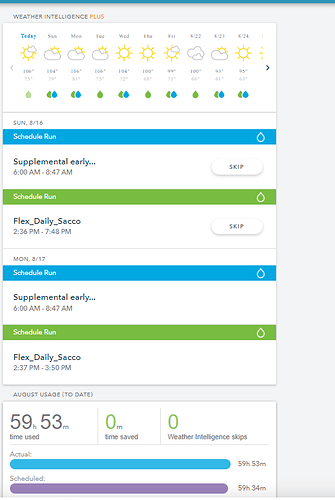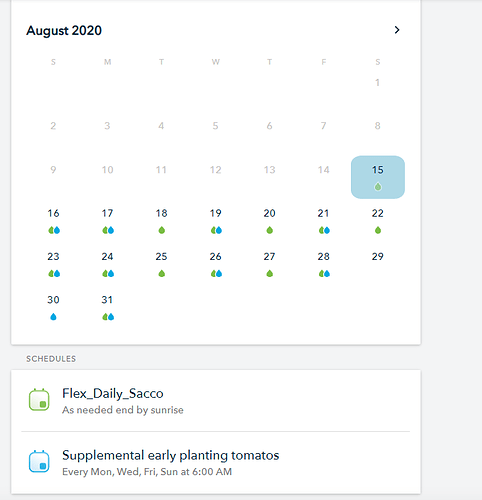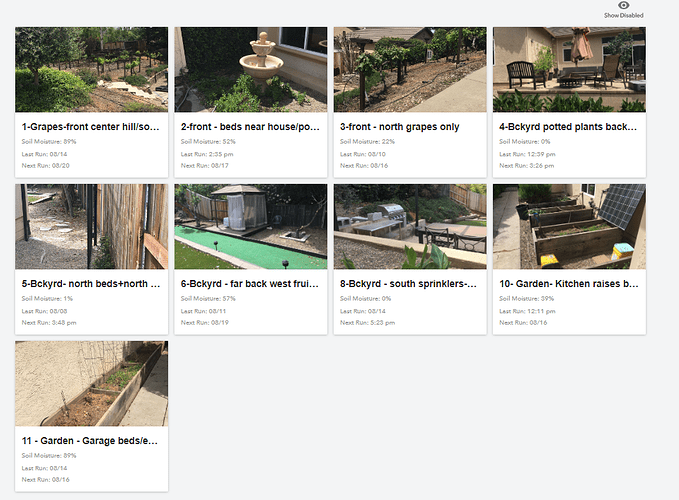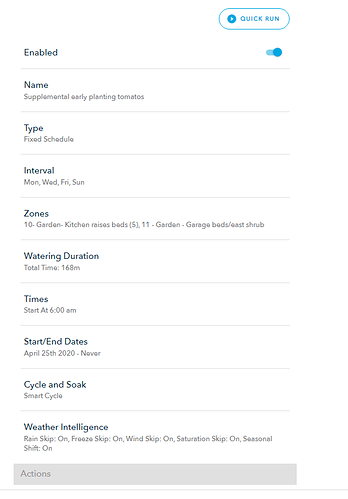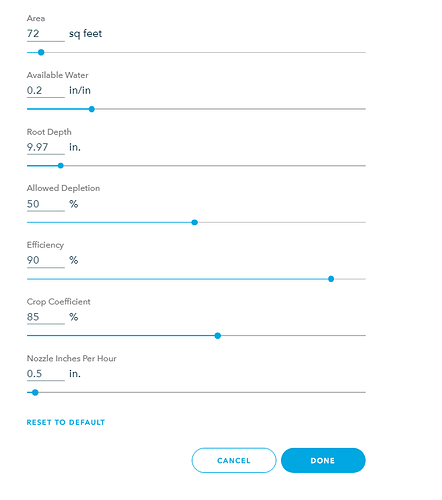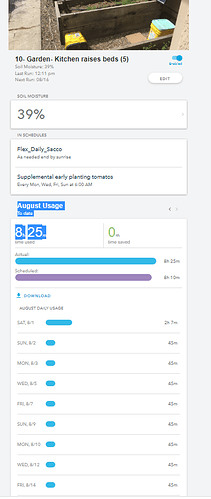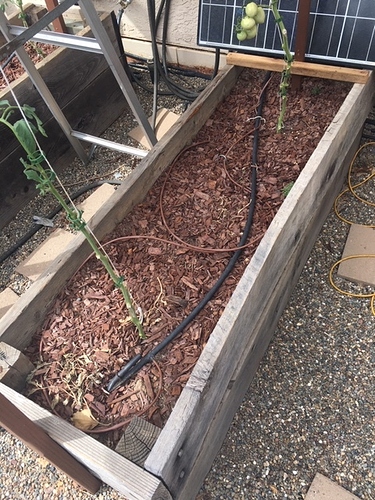We are experiencing over 100 degree hot weather currently. But I’m noticing Rachio is not keeping up with keeping my tomato plants evenly moist. What’s up with that?
You’re going to have to provide a lot more information. Concentrating on the tomato plants, what Schedule type are you using, how big is the area, what are all your settings, what is the Rachio calculated minutes of watering time, etc.
THanks for the reply. I’m two months into using a Rachio controller. My MAY usage was 5,200 Gal. / 80 hrs. and JUNE usage was 6,700 Gal. / 128 hrs.
I run a Flex daily schedule and a supplemental program for my tomatoes in rasied beds (120 sq ft) that is scheduled for M,W,F, and Sun.
My raised garden tomato beds are approx 120 sq ft. According to AUGUST watering Rachio has been watering them 45 minutes a day. Yet I’m constantly having to go out in the morning and manually add water to the beds.
Also, why does Rachio not track any water savings for me. Did I not set up Rachio correctly?
@Bsac Water savings compared to what? Are you looking for information on whether you are using less water than you used with your old controller? If that is what you are after, how would Rachio know how much water you used in the past?
If you download your data using the csv download provided under the home tab dashboard that shows the watering schedule at the top. If you scroll down there is a download button. When you get that file open there is a category (row) for Savings data. It includes columns for hours and gallons… So, I’m assuming this is a placeholder for data that Rachio is suppose to produce.
@Bsac As far I know the only savings that Rachio reports are hours or gallons saved due to weather intelligence skips. That’s the same information that appears on the main page of the app. And unless you have a flow meter the gallons saved are calculated based on your set up so may not be accurate.
Have you had any weather intelligence skips?
So, I don’t get it. I’m running a daily flex schedule plus a supplemental program for my raised garden beds that run on M, W, F and Sunday. My savings are Zero. Is this correct? Or is the weather intelligence part of my software not working?
@Bsac I am still unclear about how you are watering your tomato beds. What do you mean by supplemental program? Rachio has three types of schedules, Fixed, Flex Monthly and Flex Daily. There isn’t a supplemental program. Can you provide screen shots of the zone set up for your tomato beds, including the advanced settings and screen shot of the setup for the schedules you use to water your tomato plants.
Weather Intelligence skip savings is when a schedule is supposed to run but did not because of rain, wind, temperature. Do you have those set in your schedules and have you had any weather that would cause a skip? And remember that rain skip doesn’t apply to flex daily schedules.
Rachio does not track water savings for Flex Daily schedules. A couple of years back there were some lengthy discussions on this in the forum, and as I recall there was some agreement that it would be very difficult to do, since Flex Daily just waters when you actually need it. With a fixed daily schedule, you can keep track of the fact that you skipped watering because you got rain, so you CAN show a savings. With Flex Daily, what would you have to compare it to?
I assume that was total water usage for all your zones.
You say here you are watering the tomatoes 4 days a week.
Here you say Rachio is watering the tomatoes every day, or maybe you just mean 45 minutes each of the 4 days per week? It would be great to know how many gallons are used on your tomatoes for each watering. But just guessing, with a 10’ x 12’ area, maybe 20 tomato plants max. If each has a 1 gph emitter (again, we don’t know if these are sprinkler heads, drip lines, or what), that would give 20 gallons for each hour of watering. Or about 20 x 4 days x 45 min / 60 = 60 gallons a week. 60 gallons over 120 square feet is about 0.8" per week. If that would be the case, it sounds low.
But really, it’s silly for me to guess what your tomato zone is comprised of. All we know is that it’s tomatoes, and the bed is raised and 120 square feet, it’s watered 4 times per week for about 45 minutes each time. What is your soil? What kind of sprinkler heads do you have? Have you measured the gpm flow over a given time for the zone? If not, that should be your first step. Have you been watering this bed all along (May, June, etc.)? If so, when did they start drying out? What schedule type Rachio are you using for them?
As others have mentioned, Rachio only actually tracks savings due to rain skips. It may well save you money, if you water the appropriate amount, instead of overwatering, etc., but it has no idea about that.
No, not trying to compare old controller to new controller.
Just trying to understand why Rachio has built-in Savings data reports into their interface when you are not pushing any kind of savings data to the customer. There seems to be a User Interface disconnect here, no?
So, didn’t you guys recall all water flow meter units and you stopped support them? Please correct me if I’m wrong.
SO, if this true, why do you still have savings data reports in your interface? It’s just confusing your customers.
You ask, “Have you had any weather intelligence skips?” According to my HISTORY report, there are ZERO weather Intelligent skips.
these raised beds are 2’ x 6’ and I have (6) of them. So, I have 72 sq ft of watering space.
Soil in these beds are currently dry under the mulch 3".
I use the line emitting drip - see brown 1/4" tubing.
Below are all my settings in rachio. ZONE 10 are the raised beds for tomatos.
@Bsac If you haven’t had any weather skips that’s probably because where you live you haven’t had any rain or wind to trigger a skip.
BTW most people here are Rachio users not employees.
Thanks for posting all that. It’s very helpful, and you have an impressive array of zones.
The first thing I would do is to take your raised beds OUT of your Flex Daily schedule. While Flex Daily can handle multiple types of zones, those are VERY different than the norm, and IMHO are best handled separately.
Ending watering before Sunrise is a nice idea, but with 16 hours of watering, you don’t have much control. Since a single Flex schedule will always start watering as if it’s going to water ALL zones, and use the entire time, in your case this will begin watering about mid afternoon, watering all night. Night time watering does conserve water, but can cause a lot of problems, but I’ll not get into that here.
Let’s talk about your tomatoes: While you said raised beds, in my mind I thought one large bed. With small beds like you have, that is VERY different than the same plants in the ground. The good news is you have great soil in there, I’m sure. If your plants are drying out, then, you probably don’t have the raised beds lined with waterproof material (not that you should or shouldn’t, just saying). I believe, then, that after each watering cycle, much of the water is simply draining out of the raised beds, between gaps in the boards and at the bottom.
Maybe some others here are much more familiar with this arrangement’s watering needs, but IMHO the water will evaporate MUCH more quickly with this arrangement. You will need to water much more often to keep them at the proper moisture level. And I don’t think any standard Rachio setting will work. If you HAVE lined the raised beds with waterproof material, then I doubt they would be drying out the way they are. Many might say it’s bad to waterproof such a bed, that the plants will drown. Well, it’s really no different than a planted area with irrigated ground all around it. Each area has to exist on its own, for water requirements.
Again, on watering, even though the tomatoes are watered near the end of the cycle, on many days when not all zones are being watered, they will be watered in the middle of the night, possibly draining overnight, then have no water during the entire day. Personally, I would water them during the day, maybe start late morning. I like to do all my drip zones that way. You don’t lose much due to evaporation with the drip irrigation system and mulch, and this will help insure they don’t dry out during the hottest weather.
The standard watering time for the tomatoes, which is determined by the soil Available Water, Root Depth and Allowed Depreciation, will be designed to provide 1" of water (0.2 x 9.97 x 0.50). You probably can’t or shouldn’t apply more per day. While that amount should normally last 2-3 days, I suspect, as mentioned above, that it doesn’t all stay there, that much of it will evaporate. The good news is you have pretty good access to the soil, even toward the bottom. If you use a moisture meter, right after watering, then every day or more often, at various locations and levels, you should get an idea when the soil is drying out. Drying out the surface is not a big deal; drying it out 6" below the surface is a real problem. And of course, if your plants are still young, you probably don’t need to fully water to the 10" root depth; reducing the depth reduces the water applied at one time, but will increase the frequency, when using Flex Daily. Although for this zone, I believe a Fixed schedule might suit you better, with Seasonal Adjustment ON. Vary your time of watering to keep the mid area of your soil from drying out too much before the next watering. If it does drain out easily, you may have to water every day, and Seasonal Adjustment will reduce total watering time in cooler weather.
Sorry for being so wordy, that’s just me. And I’m not an expert, but I’m not sure you’ll find to many that will know a lot about your particular situation. For all your raised beds, if they can drain, I’d probably keep your existing schedule, water during the day, and keep an eye on whether the plants dry out or not, adjusting watering time to suit. None of the fancy Advanced factors apply in that particular case. Trial and error may well be best.
I’m just guessing but simply reducing the root depth a bit like 5", so you don’t want as much per watering. And upping depletion to like 75% to increase how often you water (but less each time). Also, did you verify you emitter is 0.5inch/hr?
You could just ignore that and keep tweaking allowed depletion, root depth, and crop coeff to get watering rates you want.
Both Root Depth and Depletion determine only how much water is applied at once. With the above example (0.2 x 9.97 x .50 = 1"), reducing root depth to 5 lowers water applied to 0.5" each time. Increasing Depletion to 0.75 increases water applied to 1.5" each time (and will actually /decrease/ how often you water, not increase it). Using both gets you something in between, 0.75", changing it less than just the root depth.
Rather than changing a bunch of variables which really don’t suit the situation, I’d just change the minutes of water and frequency manually, since it’s all trial and error at this point.
Noticed the same thing… I’d thought I’d stabilized my settings for best results throughout the year, and they worked great last year, but this year Colorado hit a stretch of extremely hot and dry conditions, our plants and two trees getting brown and crunchy, so I’d rather expected Rachio to “keep up” but instead it made an automatic Seasonal Adjustment and REDUCED the run times and amount of water applied. Since I have a personal weather station on my roof and pointed Rachio Weather Intelligence to use it when I first installed Rachio, it begs the question… does the Seasonal Adjustment algorithm even consider data from a homeowner’s Personal Weather Station? Or is Seasonal Adjustment just a “blind” protocol based only on the annual
calendar?
I’m actually spending MORE time futzing around with my irrigation INSTEAD of LESS time which I thought was the goal of this damn unit. Rachio’s support is virtually non-existent with a hands-off policy toward their early-adopter customer-base. Seems like it should be the other way around. Not impressed with this product. I warn others to steer away based upon my experience.

